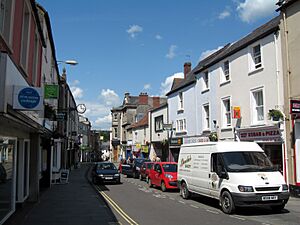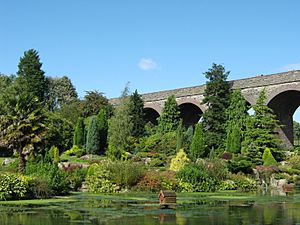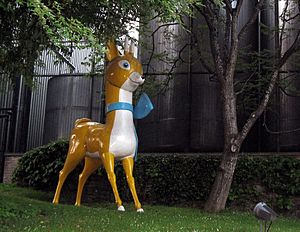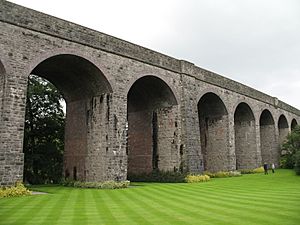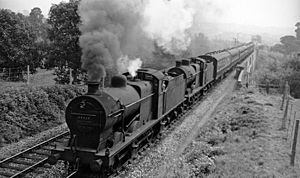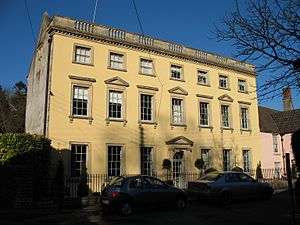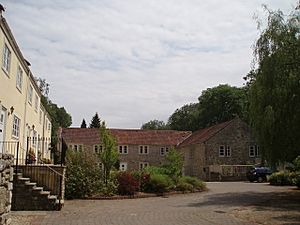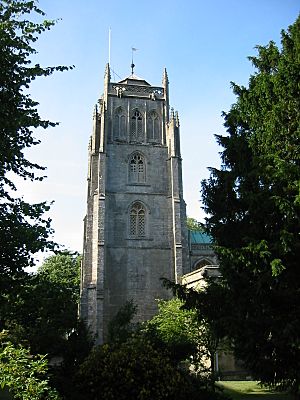Shepton Mallet facts for kids
Quick facts for kids Shepton Mallet |
|
|---|---|
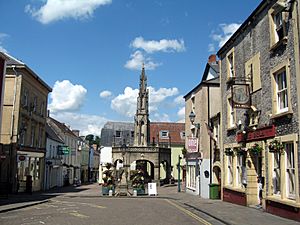 The historic marketplace, with the Market Cross |
|
| Population | 10,810 (2011) |
| OS grid reference | ST619438 |
| • London | 106 mi (171 km) E |
| Unitary authority |
|
| Ceremonial county | |
| Region | |
| Country | England |
| Sovereign state | United Kingdom |
| Post town | SHEPTON MALLET |
| Postcode district | BA4 |
| Dialling code | 01749 |
| Police | Avon and Somerset |
| Fire | Devon and Somerset |
| Ambulance | South Western |
| EU Parliament | South West England |
| UK Parliament |
|
Shepton Mallet is a historic market town located in Somerset, England. It's about 16 kilometres southwest of Bath and 18 kilometres south of Bristol. The town had about 10,810 people living there in 2019.
The beautiful Mendip Hills are to the north, and the River Sheppey flows right through the town. You can also find the old Roman road called the Fosse Way here, which was a major route for the Romans. Shepton Mallet has a long history, with signs of Roman settlements and a medieval church. The famous Shepton Mallet Prison, once England's oldest, closed in 2013.
In the past, the town was known for its wool trade. Later, in the 1700s, brewing became important. Today, Shepton Mallet is still famous for making cider. It's also the closest town to the huge Glastonbury Festival and near the showground for the Royal Bath and West of England Society.
Contents
A Look at Shepton Mallet's Past
The name Shepton comes from old English words meaning 'sheep farm'. In 1086, it was called Sceaptun. The second part of the name, Mallet, comes from the Norman Malet family, who leased land from Glastonbury Abbey around 1100.
Ancient Times
Archaeologists have found signs of people living in the Shepton Mallet area a very long time ago. They discovered Neolithic (New Stone Age) tools made of flint and pieces of pottery. There are also burial mounds from the Bronze Age that held ashes of people who lived here.
During the Iron Age, people built roundhouses near what would become the Fosse Way. They left behind tools and beads. There's also evidence of Iron Age farms and even cave homes in Ham Woods nearby.
Roman Life in Shepton
Shepton Mallet is located halfway between the Roman towns of Bath and Ilchester on the Fosse Way. Even though you can't see many Roman buildings today, archaeologists have found lots of evidence of Roman life. They found pottery kilns, which were used to make pots, suggesting that Roman soldiers were active here in the 1st and 2nd centuries.
Many Roman coins and brooches have been found, showing that people lived and traded here for centuries. In the 1990s, archaeologists found a large Roman cemetery. Some graves were aligned east-west, which might mean the people were early Christians. Other graves were aligned north-south, possibly for people who followed older, pagan beliefs. One special find was a stone coffin under what used to be a large tomb.
During these digs, a Chi-Rho amulet was found. For a while, people thought it was one of the earliest signs of Christianity in England. However, later tests showed it was actually made much more recently, in the 1800s!
The excavations also showed that a settlement stretched along the Fosse Way. It had cobbled streets, workshops, and houses made of wood and stone. Many items were found, including pottery, jewelry, tools, and coins from all over the Roman Empire. This shows that people lived here from the late 1st century to the early 5th century. It was a busy place, even if it wasn't officially a Roman town.
Saxon and Norman Times
There are some signs of Saxon settlement, including old stonework in the parish church. In 706, a king named Ine gave this area to Glastonbury Abbey.
After the Norman Conquest in 1066, the land eventually passed to the powerful Malet family. They added their name to the settlement, and that's how it became Shepton Mallet.
The Middle Ages
The Malet family owned the estate for many years. Over time, the land changed hands several times, often due to wars or changes in kings. Eventually, in 1536, Glastonbury Abbey was closed down by Henry VIII, and Shepton Mallet became part of the Duchy of Cornwall.
Shepton Mallet started to grow and become more important in the 1200s and early 1300s. The town was granted permission to hold markets and fairs. However, the Black Death hit the town in 1348, reducing the population to only about 300 people.
Later, in the late 1300s and early 1400s, skilled workers and traders from France and other parts of Europe came to England. They helped the town's economy grow by introducing cloth-making. This, along with the local wool trade, became a very important industry in Shepton Mallet.
Civil War and Rebellions
In 1625, a House of Correction (a type of prison) was built in Shepton Mallet. During the English Civil War, the town supported Parliament. Shepton Mallet mostly avoided big battles, but there was a peaceful standoff in the market place in 1642. Later, in 1646, soldiers loyal to Oliver Cromwell reportedly destroyed the church organ.
In 1685, during the Monmouth Rebellion, the Duke of Monmouth visited Shepton Mallet. Many local men joined his cause. After Monmouth's defeat, 12 of his supporters from Shepton Mallet were executed in the Market Place.
In 1699, Edward Strode built almshouses (homes for poor people) in the town.
From the 1700s to Today
In the 17th and 18th centuries, the wool and cloth industries continued to do well, using the River Sheppey for power. There were many mills in the area. However, when new machines were introduced, it caused riots in 1775, and two men died. This made mill owners hesitant to modernize, which meant Shepton's cloth trade couldn't compete with steam-powered mills in northern England in the 1800s.
Later, making silk and crepe helped the town's economy. Shepton's mills even made the silk for Queen Victoria's wedding dress! But these industries eventually faded too.
As wool and silk declined, other industries grew. Brewing became very important in the 1800s and 1900s. The Anglo-Bavarian Brewery, built in 1864, was the first in England to brew lager. It even exported beer all over the world! It closed in 1921. However, Shepton Mallet is still a major center for cider production, being the home of Babycham.
The town's population stayed fairly steady in the 1800s and early 1900s. In 1801, it was 5,104, and by 2001, it had grown to 8,981.
How Shepton Mallet is Run
Shepton Mallet is part of the unitary authority area of Somerset Council. The town has its own council with 16 members, split between two areas: Shepton East and Shepton West. These council members are elected by the people of the town.
For national elections, Shepton Mallet is part of the Wells parliamentary constituency. Since 2015, the Member of Parliament (MP) for this area has been James Heappey from the Conservative Party.
Important Services
Shepton Mallet has two doctor's offices and a community hospital. There's also a special surgical center for certain procedures. The closest large hospital is in Bath.
The town has a fire station and an ambulance station. The police station, which closed in 2014, reopened in 2020.
Shepton Mallet's Location and Nature
Shepton Mallet is in the southern part of the Mendip Hills. The ground here is made up of different types of rock, like limestone.
Nearby Caves
To the north of the town, you can find several caves of the Mendip Hills. Some of these, like Thrupe Lane Swallet, are special geological sites. The St. Dunstan's Well Catchment is a large cave system with about 4 kilometres of passages. Many caves, like those at Fairy Cave Quarry, have amazing formations such as stalagmites, stalactites, and calcite curtains. Shatter Cave and Withyhill Cave are known for their beautiful white calcite deposits.
Small numbers of different types of bats, like the greater horseshoe bat and lesser horseshoe bat, hibernate in these caves.
Surrounding Countryside
The land around Shepton Mallet is mostly used for farming, but there are also some woodlands. About 1.8 miles northeast of town is Beacon Hill Wood, which has ancient burial mounds. To the northwest are Ham Woods, where you can see old railway tunnels and a viaduct. The East Mendip Way walking path goes around the northern edge of Shepton Mallet and through Ham Woods.
Southwest of town is the Friar's Oven, a special grassland area with many types of herbs. Northeast of town, you'll find Windsor Hill Quarry and Windsor Hill Marsh, a marshy pond with interesting plants, including some that are rare in Somerset.
The River Sheppey
The oldest parts of Shepton Mallet are next to the River Sheppey, at the bottom of a valley. The river flows underground through much of the town. Sometimes, after heavy rain, the river can flood, as it did in 2006 and 2008. To prevent this, a flood protection project was built in 2010.
Areas of the Town
Shepton Mallet has several distinct areas that were once separate communities. The town center has two main streets: High Street and the pedestrian-only Town Street. The parish church is to the east. Lower Lane, which runs under Waterloo Bridge, is one of the few places where the River Sheppey flows above ground.
Garston Street has old weavers' cottages from the 1600s. The cider breweries are now in this area. Across Kilver Street is Kilver Court, which used to be a factory and the headquarters for the Showerings brewing business. Behind it are the beautiful Kilver Court Gardens, which are now open to the public. On the eastern edge of town is Charlton, with former breweries and mills that are now a trading estate.
On the south side of town is Tadley Acres, a new housing development built on land partly owned by the Duchy of Cornwall. It's known for its good design and use of local materials. The Mid-Somerset Showground is also nearby. Southwest of the town center is the Townsend Retail Park, built in 2006–2007, which has shops and a supermarket.
West Shepton, in the southwest, is home to the former Shepton Mallet Workhouse, built in 1848. It later became the Norah Fry mental hospital and is now housing. Nearby is the modern community hospital. Further north are the hamlets of Darshill and Bowlish, which have old mills and grand houses.
Weather in Shepton Mallet
Shepton Mallet has a temperate climate, meaning it's generally wetter and milder than other parts of England. The average temperature is about 10°C (50°F). July and August are the warmest months, with highs around 21°C (70°F). December is usually the cloudiest month, and June is the sunniest.
Rainfall is around 800–900 mm (31–35 inches) per year, often from Atlantic storms or summer showers. Snowfall is typical for about 8–15 days a year. The wind usually blows from the southwest.
People and Jobs
In the 2001 census, Shepton Mallet had 8,981 people, with slightly more females than males. About 22% of the population was aged 16 or younger.
Around 66% of people aged 16–74 were employed. Most jobs were in service industries, but also in manufacturing, quarrying, and construction.
Locally, some people feel that Shepton Mallet's economy has been slowing down. However, while manufacturing jobs have decreased, new jobs have appeared in areas like distribution, business services, and health. This has created a more balanced economy.
The town center has seen improvements, especially in the pedestrianized Town Street. Since 2004, there have been grants to help repair buildings and improve public spaces.
The traditional Friday market in the Market Place has declined over the years, but there are efforts to make it more lively again.
The Haskins furniture store, which started in Shepton Mallet in 1938, has its main showroom here, along with other shops like a supermarket. A new shopping center with a Tesco supermarket opened in 2006–2007. This caused some debate, with some people welcoming the new shops and others worrying about local businesses. The Mulberry Factory Shop is also located on Kilver Street.
Shepton Mallet has been important for alcoholic drinks. While the Gaymer Cider Company closed in 2016, Constellation Brands still makes Babycham. The family-run Brothers Drinks produces Brothers Cider and bottles drinks for other companies. In 2016, Brothers Drinks took over the cider factory.
The Royal Bath & West Showground, just southeast of town, hosts many events. These include the annual Royal Bath and West Show, Christian festivals, antique fairs, and other exhibitions.
Getting Around
The A37 runs north-south through Shepton Mallet, following the old Fosse Way. The A361 and A371 also pass through the town.
Shepton Mallet used to have two railway stations, but both are now closed.
- Shepton Mallet (High Street) opened in 1859.
- Shepton Mallet (Charlton Road) railway station opened in 1874.
Both stations closed in the 1960s as part of the Beeching cuts (a plan to close many railway lines). Today, the closest train station is Castle Cary, about 13 kilometres south. There are plans to bring passenger train services back to Shepton Mallet.
Bus services are provided by First West of England. There's also a daily coach service to London.
Famous Places to See
Shepton Mallet has 218 listed buildings, which means they are protected because of their historical importance. The town center and areas like Bowlish are conservation areas, meaning their historic character is preserved.
The hexagonal market cross in the town center is 50 feet high and dates back to 1520. Nearby is The Shambles, an old market stall. The former HM Prison Shepton Mallet, built in 1610, is close to the town center. It closed in 2013 and has since been sold for housing development.
You can find several beautiful old houses in areas like Lower Lane, Leg Square, Charlton, and Bowlish. Old Bowlish House, built in the early 1600s, was later updated in the Palladian style. Bowlish House, now a hotel, was built in 1732 by a wealthy cloth maker.
In the hamlet of Darshill, there's an old silk-drying shed, also called a handle house. It has many holes in its walls to help dry teasle heads, which were used to make cloth soft.
The Anglo-Bavarian Brewery, built in the 1860s, is still a major landmark. Nearby is the old workhouse that became the Norah Fry Hospital and is now housing. There are also two disused railway viaducts, including the Charlton Viaduct with its 27 arches.
The market cross, the prison, the Merchants House, the Anglo-Bavarian Brewery, Charlton Viaduct, the former St Michael's Roman Catholic Church, Bowlish House, Old Bowlish House, and Park House are all highly protected Grade II* listed buildings.
The town center was updated in the 1970s. A new library was built, and an entertainment complex called The Centre (now The Academy) was added.
Shepton Mallet has a large park called Collett Park, which opened in 1906. It was a gift to the town from John Kyte Collett, who wanted to provide a public green space.
Places of Worship
The parish church of St Peter and St Paul is a very old building, dating back to the 12th century. Most of what you see today is from the 15th century. Its oak wagon roof is famous, with 350 different carved panels and 36 carved angels. It's considered one of the finest in England!
The old Roman Catholic Church, built in 1804, is now a warehouse. A newer Catholic Church was built in 1966. The Salvation Army has meeting rooms, and the local Methodists share the parish church with the Anglican congregation. There's also a Baptist Chapel built in 1801.
Schools in Shepton Mallet
Shepton Mallet has one primary school, St Paul's Junior School, and two infant schools, Shepton Mallet Infants School and Bowlish Primary School.
For students aged 11–16, there's Whitstone School, which is a Technology College. After age 16, students usually travel to colleges in nearby towns like Frome or Street.
Fun and Culture
A town festival called Collett Day is held every June in Collett Park. In August, the free Mid-Somerset Show takes place in fields on the edge of town.
The huge Glastonbury Festival, Europe's largest music festival, is held just a few miles southwest of Shepton. The town also hosts an annual Shepton Mallet Digital Arts Festival.
In November, Shepton Mallet has a carnival with amazing illuminated floats and people in costumes. It's part of the West Country Carnival Circuit.
The complex in the town center, now called The Academy, used to be a performing arts school.
The town's weekly newspaper is the Shepton Mallet Journal. Local news is also covered by the Shepton Gazette and other magazines. You can listen to local radio stations like BBC Radio Somerset and Radio Shepton, which is a community station online.
In 2007, Shepton Mallet became famous internationally when a local cheesemaker broadcast the aging process of a huge Cheddar cheese called Wedginald. Over 1.5 million people watched it online!
In 2010, a TV show called Turn Back Time – The High Street was filmed in the town center. It showed families running traditional shops as they would have been in Victorian, Edwardian, World War II, and 1960s/70s times.
Sports and Hobbies
Shepton Mallet has a Non-League football club called Shepton Mallet F.C. They play at the Playing Fields. There's also a hockey club that plays at the Leisure Centre.
The town has a lawn bowls club with a bowling green. Shepton Mallet also hosts a park-run, which is a free 5-kilometre running event held every Saturday morning in Collett Park.
Famous People from Shepton Mallet
- Christopher Cazenove (1945–2010), a well-known actor, lived in Bowlish as a child.
- John Lewis (1836–1928), who started the famous John Lewis department store, was born in Town Street.
- Francis Showering (1912–1995), who invented the popular drink Babycham, was born in the town.
- Madeleine Harris (born 2001), an actress who starred in the Paddington movies.
Twin Towns
Shepton Mallet is twinned with:
- Misburg in Germany
- Bollnäs in Sweden
- Oissel sur Seine in France
See also
 In Spanish: Shepton Mallet para niños
In Spanish: Shepton Mallet para niños





